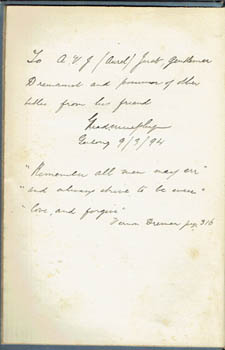
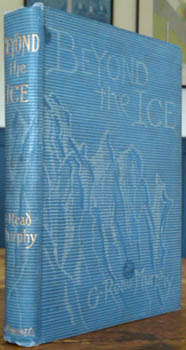

MURPHY, G. [George] Read. Beyond the Ice. Being a story of the newly discovered region round the north pole. Edited from Dr. Frank Farleigh's diary. London, Sampson Low & Melbourne, Hutchinson [1894]. Octavo publisher's illustrated blue cloth (two small blobs of wax on the front cover, marks on the back). Somewhat canted, not a bad copy of a book guaranteed to respond badly to handling. A signed presentation, dated March 1894, from Murphy to Geelong lawyer Aurel Just, "gentleman, Dremanist and possessor of other titles," with a quote from his character Vernon Dreman. Au$950
Only edition of this polar utopia and dystopia which Geelong author Murphy - I suspect simple perversity - took to the opposite end of the world in defiance of the usual Australian practice of heading south. Heaps of scientific advances and flying machines as expected but reform and enlightened progress can only go so far: adult women are enfranchised until they marry, then the possible conflict between husband and wife is not worth the candle.
"The chief characters seem to spend a deal of unnecessary time in consuming oysters and brown bread" warned the North Melbourne Courier and West Melbourne Advertiser in an otherwise warm review while suggesting it would be commercially more canny to set the book in central Australia.
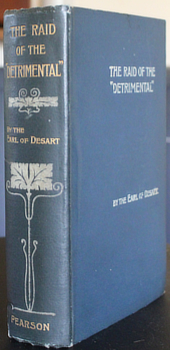
[CUFFE, William Ulick O'Connor]. The Earl of Desart. The Raid of the "Detrimental". Being the true history of the great disappearance of 1862; related by several of those implicated ... London, Pearson 1897. Octavo publisher's decorated cloth blocked in gilt and white. A hint of browning; quite good. Au$300
Only edition of this lively high society/South Seas/feminist/lost race fantasia which sees a clutch of England's finest damsels kidnapped by well bred wastrels and yachted away to a South Sea island. Soon they come across the less necessary half of a race, seemingly of Mediterranean origin, whose women leave all men between childhood and dotage on another island and visit once a year. Our aristocratic bandits discover that being British and useless is useless when young women can have their choice of good looking capable men. It's only short step to a polygamous queendom.
This seems to result in a mulitude of children. I suspect that Desart didn't think through the mechanics of woman run polygamy but perhaps I misjudge him. Without the usual British infant mortality rate there might not be an impossible number of kids.
This was, I think, Desart's last novel. I couldn't find much in the way of reviews but I am pleased to report that the Launceston Examiner thought it "a medley of puerilities." With a tough editor Desart might be still read today. He could write fluently and entertainingly but he did get side tracked easily, sometimes forgetting what novel he was writing. His Lord and Lady Piccadilly was racing into the last bend before the home straight when he abruptly introduced a horde of new characters and turned a tragedy into a social satire for a couple of hundred pages. And he is prone to letting his cynical authorial asides overwhelm a page.
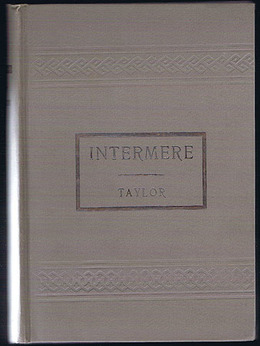
TAYLOR, William Alexander. Intermere. Columbus, XX. Century Pub. Co. 1901-1902. Octavo publisher's grey cloth; 148pp, frontispiece portrait. An inserted publisher's card advertising the book has made a faint brown patch on the title but this copy is pretty well as new. Au$250
First edition. An Antarctic lost race race utopian thriller. Again a ship, or in this case yacht, is enveloped in fog; comes a mighty storm and the narrator finds himself in an unknown land. Intermere is populated by a physically, mentally, scientifically and socially advanced race.
The book exists in a plethora of different coloured cloths but I don't know of any, and don't see any reason to look for, issue points.
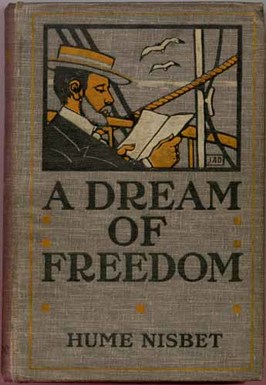
NISBET, Hume. A Dream of Freedom, romance of South America. London, F.V. White 1902. Octavo publisher's illustrated cloth blocked in ochre, white and black; xii,318pp, frontispiece. Some minor browning and signs of use but rather a good copy. Tipped in the front opening is an original photo of Nisbet dated 1901 and a notice of this book. Au$850
Only edition and rare. And rare in more than one sense. It is the only novel that I know of set in the William Lane led utopia of New Australia and Cosme in Paraguay; in fact it is one of very few contemporary books on the settlement (the only other that I know of is the vitriolic 'Where Socialism Failed'; 1912). Likewise it is one of very few novels set in an actual utopia - or at least an attempt at one.
Nisbet's preface is a mildly petulant jab at his critics and sounds a weary note about having written more than forty novels without repeating himself. As his first novel (set in New Guinea) appeared only 14 years earlier it's a not unimpressive achievement on some level. The author of the newspaper notice inserted at the front was alarmed at the implied threat that this could be his last novel and must have been relieved as more novels appeared later the same year. But there weren't many more novels - and they petered out in 1905. In the same month (January 1902) that the freshly widowed Nisbet dates his preface he married a 73 year old widow - 20 years his senior. I wonder whether he was writing with the exhaustion of a new burden undertaken or the release from financial strain.
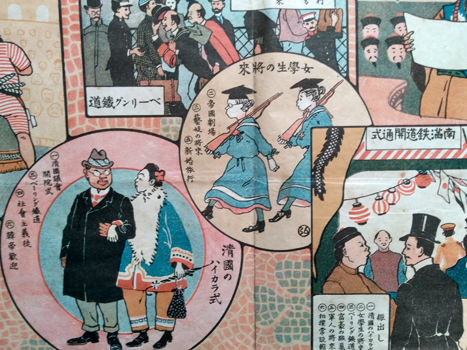
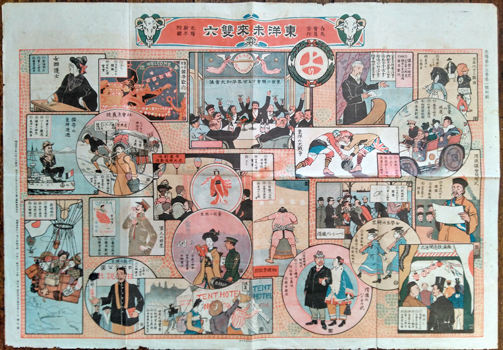
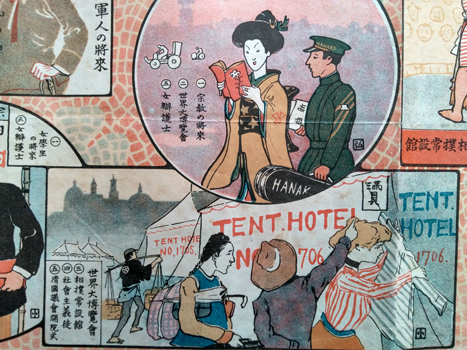
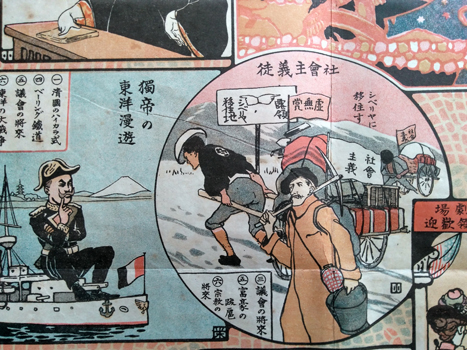

Nakazawa Hiromitsu, Kobayashi Shokichi & Okano Sakae. [Toyo Mirai Sugoroku]. Tokyo, Hakubunkan 1907 (Meiji 40). Colour printed broadside, 55x78cm. Edges nibbled, a small ink splodge, a bit browned; quite good. Au$425
A view, or a panoply of views, of a future Asia. Some of these vignettes of what's to come are obvious enough - schoolgirls at rifle drill and sumo wrestlers in striped bathers - but a few seem fairly recondite to me. I'm not sure how much is optimistic, how much is dire warning and how much is wearily stoic.
Nakazawa, Kobayashi and Okano, still young, had been fellow students at the Tokyo School of Fine Arts, and of Kuroda Seiki, and collaborated on the five volume Nihon Meisho Shasei Kiko, issued over several years.
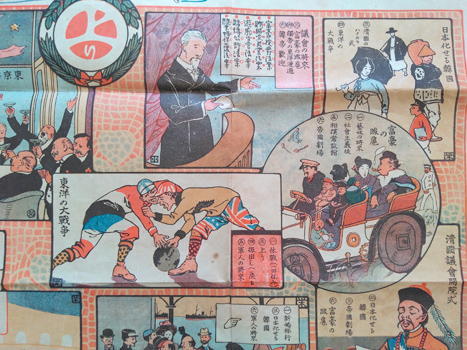
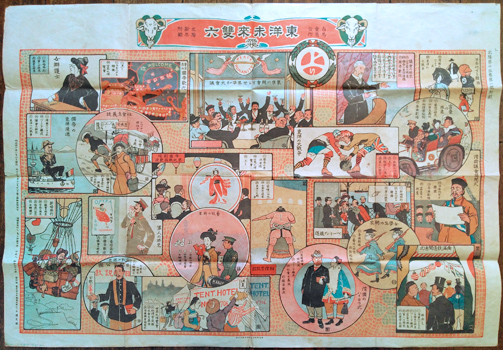
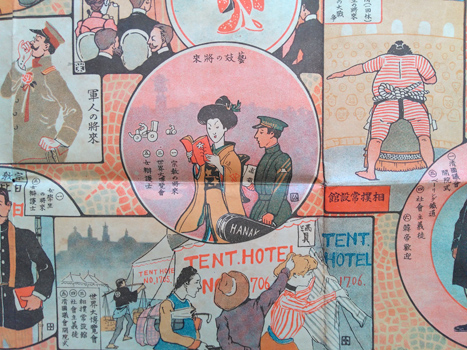
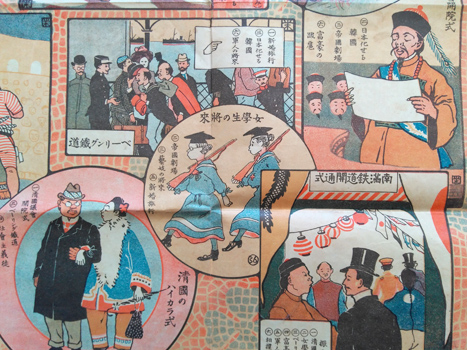

Nakazawa Hiromitsu, Kobayashi Shokichi & Okano Sakae. [Toyo Mirai Sugoroku]. Tokyo, Hakubunkan 1907 (Meiji 40). Colour printed broadside, 55x78cm. Minor flaws and signs of use, some ink splodges on the back. Au$650
A view, or a panoply of views, of a future Asia. Some of these vignettes of what's to come are obvious enough - schoolgirls at rifle drill and sumo wrestlers in striped bathers - but a few seem fairly recondite to me. I'm not sure how much is optimistic, how much is dire warning and how much is wearily stoic.
Nakazawa, Kobayashi and Okano, still young, had been fellow students at the Tokyo School of Fine Arts, and of Kuroda Seiki, and collaborated on the five volume Nihon Meisho Shasei Kiko, issued over several years.
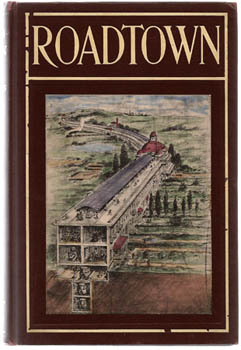
CHAMBLESS, Edgar. Roadtown. NY, Roadtown Press [1910]. Octavo publisher's cloth blocked in white with an onlaid colour illustration; [6],172pp. A little flaking of the white blocking, an excellent copy. Au$750
The deluxe issue: for an extra ten cents ($1.35 against $1.25 for plain) you could buy this with the cover illustration hand coloured. Now one of the more arcane and elusive utopian schemes for a new kind of city, leading to a new society. Roadtown is a ribbon, the extreme lineal city. At the bottom, underground, is the railway - noiseless and smokeless - above come housing, work and communal areas - each home with its own plot of land - and at the top is a promenade. In short the perfect blend of the virtues of city and country.
What surprises from this distance is how much apparently sensible support Chambless garnered. Construction was to be prefabricated concrete and Edison donated his patents; transport was by monorail and Boyes donated his patents; there was a pretty impressive list of people lending their efforts, both practical and rhetorical. Ten mile stretches of experimental or exhibition Roadtown seemed likely, even imminent, for years but Chambless beavered away at Roadtown for almost forty years, until his death in 1936, to wind up virtually forgotten.
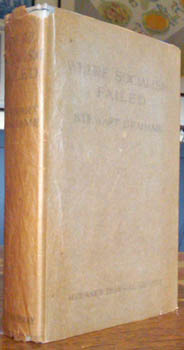
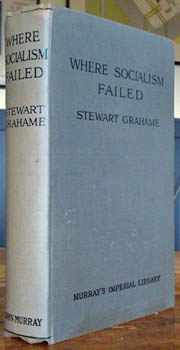

New Australia. GRAHAME, Stewart. Where Socialism Failed. An actual experiment. London, Murray 1913 [1912]. Octavo publisher's cloth; xii,266pp & publisher's list, photo illustrations & map. A rather good copy in what seems to be the original glassine wrapper. Au$125
Second printing; in Murray's Imperial Library. I'm not sure why Grahame (ie Graeme Williams) was quite so bitter about William Lane and his utopian emigration to Paraguay. In this, his most extended revilement (he had already published a couple of pamphlets), Grahame assured his readers that he spent 'over five hundred nights in a mud hut at 'New Australia'' and its easy to conclude that he was a disillusioned settler, but I'm not sure whether that explains the depth of his hatred for any communistic or socialist behavior.
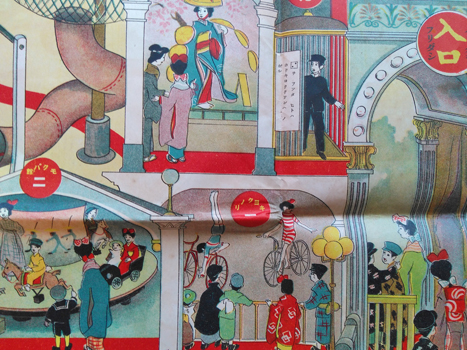
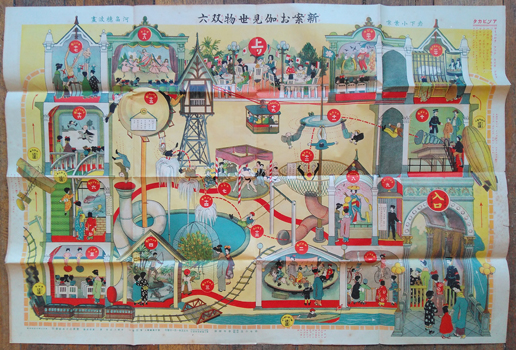
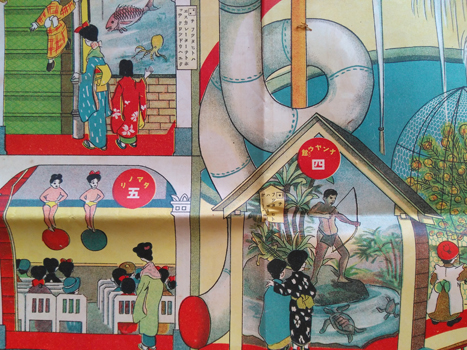
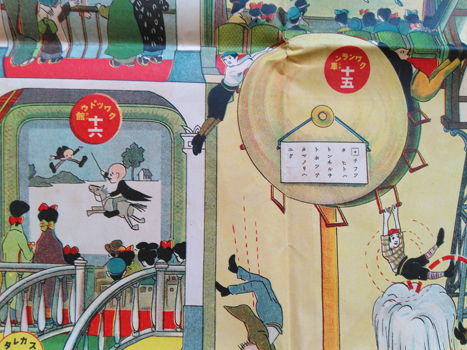

Kawabata Honami [Shin'an Otogi Misemono Sugoroku]. Tokyo, Yonen no Tomo 1916 (Taisho 5). Colour broadside 53x78cm. Edges nibbled, some browning and a couple of small flaws but pretty good. Au$485
This utopian view of a kids' paradise was the New Year gift from the magazine Yonen no Tomo. It's hard to find. This is a model for a new kind of fun palace that has a lot in common with the modern department store, which usually had fun for kids and a cafe at the top. In this case all the boring stuff - like clothes - has been stripped out and the whole emporium turned over to fun.
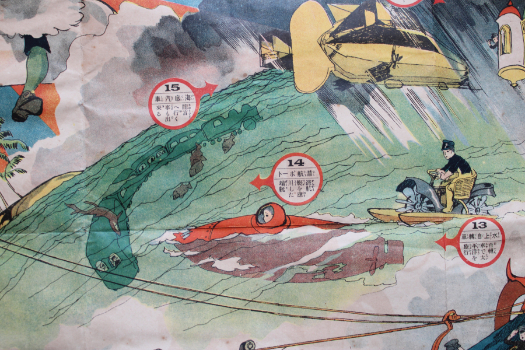
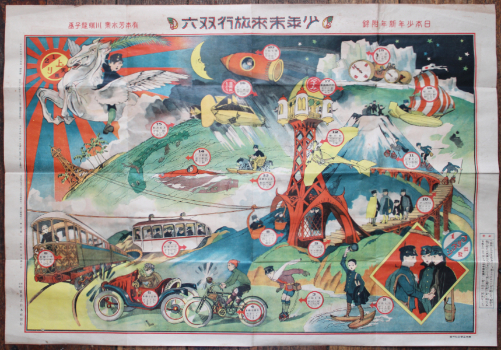
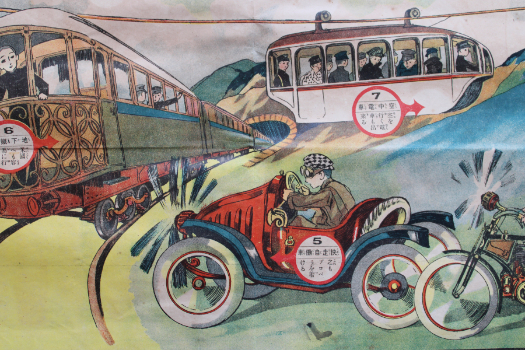
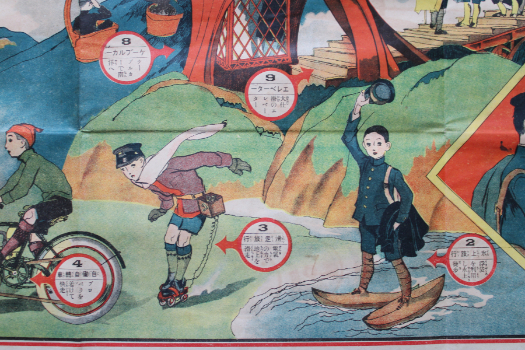

Sugoroku. Kawabata Ryushi. [Shonen Mirai Ryoko Sugoroku]. Tokyo, Nihon Shonen 1918 (Taisho 7). Colour broadside 78x54cm. Some browning and minor signs of use; not bad. Au$500
The New Year gift from the boy's magazine Nihon Shonen. A view of travel in the future, this is among my favourites of the travel adventure sugoroku and hard to find in anything like one piece. Doubtless it was a favourite with many others too.
Kawabata did several of the best, most captivating, sugoroku of the period. His career took a curious turn during a 1913 stay in America to study western painting. Apparently he was so impressed with the Japanese art he saw in Boston he switched to being a Nihonga painter. Still, he remained being an illustrator for magazines for quite some time. As did most of the early to mid 20th century artists now revered.
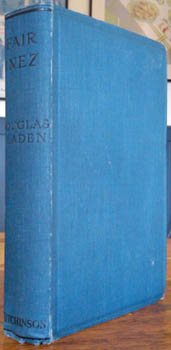
SLADEN, Douglas. Fair Inez. A romance of Australia. London, Hutchinson [1918]. Octavo publisher's cloth; 16 page publisher's list for spring 1918 at the end. Minor signs of use and some spotting or browning, a pretty good copy. Inscribed affectionately and signed by Sladen in June 1935 to "Dorothy ... another English soul who married an Australian." A small pencil note on the front paste down suggests that Sladen paid 2/6 for this copy in April 1935. If so, he's not the only author to buy their own books to give away. Au$400
First edition of this futuristic fantasy which opens in the year 2000 with the great airship Murrumbidgee from London coming into land at Melbourne. Returning home is Pat Lindsay Gordon, son of Adam Lindsay Gordon IV and great-grandson of Adam Lindsay Gordon II, in turn the grandson of a cousin of the revered poet. The Gordons obviously breed hard and fast. His sister Inez will doubtless be the femme fatale of the book. Read on yourself.
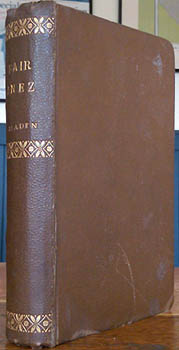
SLADEN, Douglas. Fair Inez. A romance of Australia. London, Hutchinson [1918]. Octavo contemporary brown cloth (spine lettered and decorated in gilt); 16 page publisher's list for spring 1918 at the end. Front fly removed and inner hinge cracked. Mild natural browning of the paper. Not a bad copy. Au$50
First edition of this futuristic fantasy which opens in the year 2000 with the great airship Murrumbidgee from London coming into land at Melbourne. Returning home is Pat Lindsay Gordon, great-grandson of Adam Lindsay Gordon II, in turn the grandson of a cousin of the revered poet. The Gordons obviously breed hard and fast. His sister Inez will doubtless be the femme fatale of the book. Read on yourself.
Was this published in wrappers? I see no other reason for replacing the binding when it must have still been new but I can't find a reference to wrappered copies.
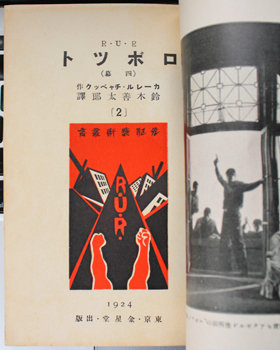
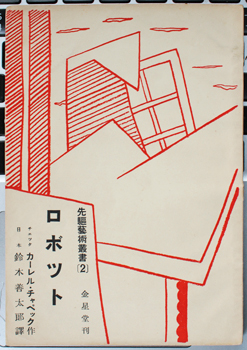

CAPEK, Karel & Suzuki Zentaro. R.U.R [R.U.R Robotto]. Tokyo, Kinseido 1924 (Taishi 13). 18x12cm publisher's illustrated wrapper; title page with Simonson's poster design for the New York production in red and black, photo frontispiece. A nice copy. Au$800
The introduction of 'robot' to the Japanese language and they've gone mad with it ever since. It isn't, however, the first published Japanese translation or adaptation of Capek's play: in 1923 that appeared titled Jinzo Ningen - artificial human - by Uga Itsuo. He seems to have been a haiku and theatre enthusiast who was working for a Japanese company in New York when the Theater Guild did their production. He has pretty much vanished from history except as a translator of RUR. And he deserves it, discarding what might be the most evocative word of our times.
I presumed Suzuki, a writer of greater consequence, produced his version as a reaction but it seems more a matter of zeitgeist. Suzuki went on a cultural world tour in 1920 and came back armed with Capek, Molnar, Eugene O'Neill, and who knows what other stage weapons. He wrote a long article on the play in 1923 and this translation predates the first production of Uga's version. It seems neither of them knew of the other's work.
Worldcat finds no copies of this outside Japan.
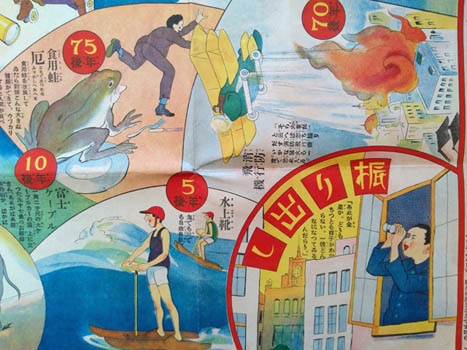

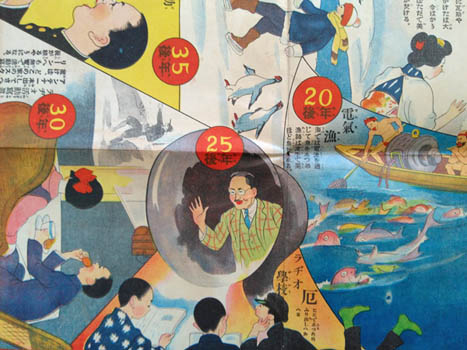


Hayashi Taidichi. [Shonen Mirai Sugoroku]. Tokyo, Nihon Shonen 1927 (Taisho 16). Colour broadside 54x79cm. Rather good. Au$450
This is a future to look forward to. Mostly. The gas warfare is not so inviting but at least the horses get protective suits. And it's only fair that giant edible frogs should have a chance to eat us. This was the new year gift from the magazine Nihon Shonen - Japanese Boy.
Hayashi redesigned Tokyo after the earthquake and fire - in 1924's new year sugoroku - to be a wonderful utopia for boys of all ages. Mostly there is no Taisho 16 but this was produced the year before, before the change in emperors.
  1 [2] 1 [2] |